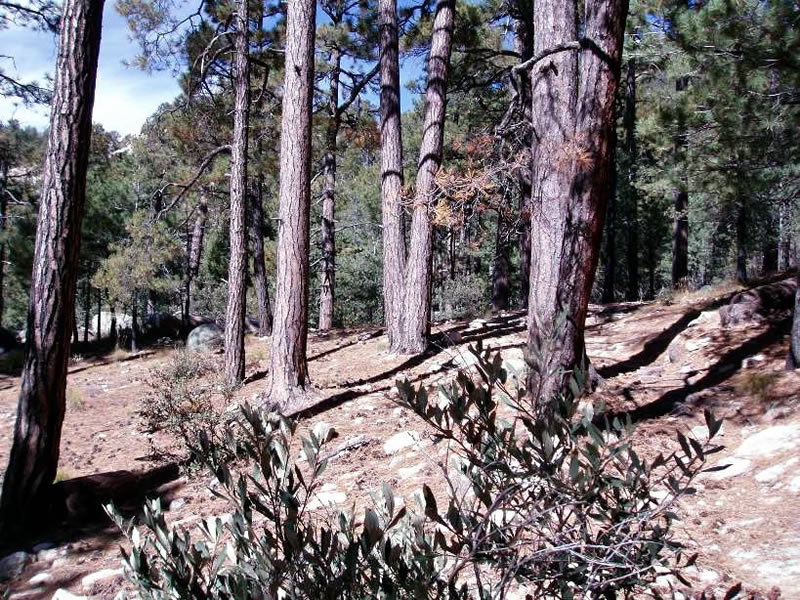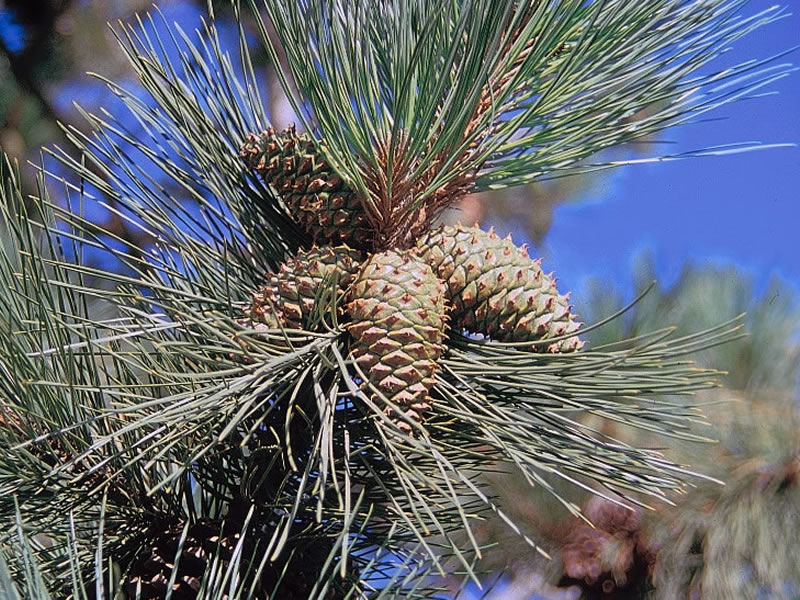Pine Forests
 A pine forest in the Pinaleno Mountains. Photo by Charlie McDonald.
A pine forest in the Pinaleno Mountains. Photo by Charlie McDonald.
 Pine forests tend to have a closed canopy and relatively little understory vegetation. Brackenfern (Pteridium aquilinum) seen here is one plant that does well in dense pine forests. Photo by Charlie McDonald.
Pine forests tend to have a closed canopy and relatively little understory vegetation. Brackenfern (Pteridium aquilinum) seen here is one plant that does well in dense pine forests. Photo by Charlie McDonald.
These forests occur at elevations of 7,000-8,500 feet. They are the highest elevation Sky Island communities with true affinities to the Sierra Madre of Mexico. Here, ponderosa pine (Pinus ponderosa var. scopulorum) from the Rocky Mountains mixes with Arizona pine (Pinus arizonica) and Apache pine (Pinus engelmanii) from the Sierra Madre. Commonly encountered understory trees like silverleaf oak (Quercus hypoleucoides), Arizona white oak (Q. arizonica), netleaf oak (Q. rugosa), Gambel oak (Q. gambelii), Mexican pinyon (Pinus cembroides), and alligator juniper (Juniperus deppeana) have both northern and southern affinities. These forests are found in the Chiricahua, Huachuca, Pinaleno, Santa Catalina, and Santa Rita mountains.
 Pine forests usually occur on dry slopes so needles that fall under the trees decompose very slowly. This thick layer of pine needles is another factor that reduces the understory vegetation. A silverleaf oak, still shrub-sized, is in the foreground of this picture. Photo by Charlie McDonald.
Pine forests usually occur on dry slopes so needles that fall under the trees decompose very slowly. This thick layer of pine needles is another factor that reduces the understory vegetation. A silverleaf oak, still shrub-sized, is in the foreground of this picture. Photo by Charlie McDonald.
 Fire destroyed this pine forest in 2004. Young pines are already replacing the dead trees. The forest in the background also burned, but the fire was not hot enough to reach the tree crowns so this forest survived. Photo by Charlie McDonald.
Fire destroyed this pine forest in 2004. Young pines are already replacing the dead trees. The forest in the background also burned, but the fire was not hot enough to reach the tree crowns so this forest survived. Photo by Charlie McDonald.
 Arizona pine. Photo by Thomas Van Devender at swbiodiversity.org.
Arizona pine. Photo by Thomas Van Devender at swbiodiversity.org.
 Ponderosa pine. Photo by North Dakota State Soil Conservation Committee at plants.usda.gov.
Ponderosa pine. Photo by North Dakota State Soil Conservation Committee at plants.usda.gov.
 Arizona pine on the left usually has five needles while ponderosa pine on the right usually has three. These two trees often grow in mixed stands and are difficult to distinguish from a distance. Photo by C.J. Earle at www.conifers.org.
Arizona pine on the left usually has five needles while ponderosa pine on the right usually has three. These two trees often grow in mixed stands and are difficult to distinguish from a distance. Photo by C.J. Earle at www.conifers.org.
Further Reading
Bennett, P.S., M.R. Kunzmann and L.A. Graham. 2004. Descriptions of Arizona vegetation represented on the gap vegetation map. (PDF)








